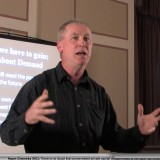EDITOR’S NOTE: This letter was originally published in the Prince George Citizen, in response to a previous article on Site C Dam.
I live in the Peace Valley, upstream of the proposed Site C dam. That has led to a lifetime interest in electricity policy. I read with interest the recent article entitled, “Site C update: more power, more cost.” (July 27) which states, “BC ratepayers will be forking over the estimated $7.9 billion to build the Site C hydro-electric dam on the Peace River…”
Hydro customers do guarantee the corporation’s debt although very few of us give that much thought. There’s been no need so long as the debt remained stable, was prudently managed, and publicly available. But things have changed. After many years of remaining stable, the debt load in the past three years has steadily climbed and those figures do not include the longterm contractual obligations for supply from BC independent power producers, which the province requires Hydro to use. The public is refused access to those contracts. How willing should ratepayers be to guarantee an additional $7.9 billion without having the right to scrutinize what they are already on the hook for?
The article says we need Site C because provincial demand is expected to rise 40% in 20 years. In the past, Hydro ratepayers could – and did – use BC Utilities Commission (BCUC) hearings to hold Hydro and its government handlers to account for their claims. But last year, the Energy Act removed Site C and ten other projects from BCUC oversight. Now ratepayers are told they’ll pay the costs but are denied a forum to check the need for and suitability of those costs.
Last year’s Energy Act requires BC to be ‘self-sufficient’ in electricity. All generation must occur within the province. Hydro must be able to meet the province’s future need under “the most adverse sequence of stream flows within historical record.” So self-sufficiency is to protect our electricity supply in times of drought. Why, then, would we build another dam and reservoir that would be subject to the same drought we’re trying to protect ourselves from? Surely it would make more sense to diversify our source of supply so that when droughts do occur, we have other sources (natural gas, geothermal, wind, solar) available.
According to the article, Site C is “extremely cost-effective” at $87-95 per megawatt. The comparable cited is $125/Megawatt for the green energy call – a most expensive source. I’m told that firm power with delivery in 2012 was recently quoted at $27-35 on the Pacific Northwest wholesale market. Longterm predictions are chancy but the projected $81-85 for 2030 doesn’t make Site C look shiny either. It appears that Site C can only be called “extremely cost-effective” if cheaper sources are somehow eliminated. The self-sufficiency requirement has created artificially expensive electricity in BC.
Ratepayers have every right to call “Foul!” when they are taken for granted in the manner we are seeing. Every avenue they might use to protect their interests is blocked. They are expected to swallow the rate increases and guarantee the risk, all while having no control over the policy. That’s wrong.
Gwen Johansson has served on numerous energy-related endeavours. She co-chaired the Northeast Energy & Mines Advisory Committee; served on BC Hydro’s Integrated Electricity Planning Committee; is a former BC Hydro Director and a former member of the BC Energy Council. She lives in the Peace Valley near Hudson’s Hope.







